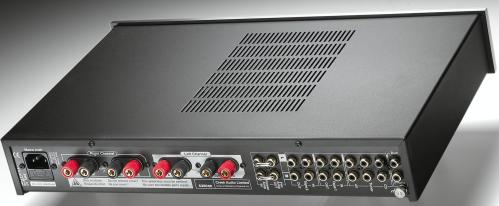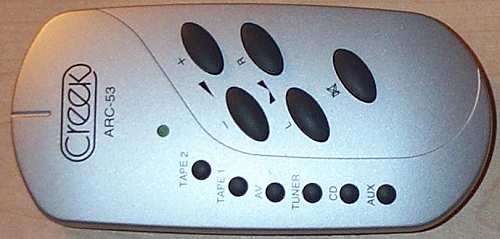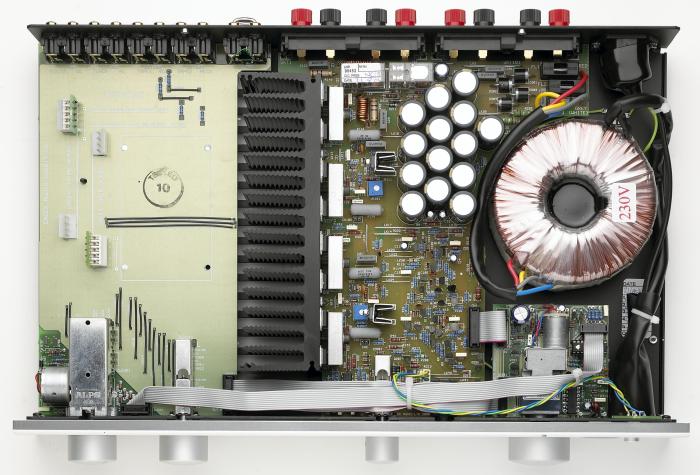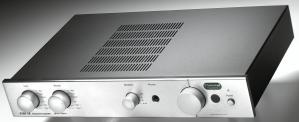Creek 5350SE Integrated Amplifier October, 2003 Arvind Kohli
|
Click Photo Above to See Larger Version |
|
Specifications Power: 85/150 Watts into 8/4 ohms MSRP $1500 USA |
Continuing my series of integrated amp reviews (integrated means it has both
preamplifier and power amplifier in the same chassis), I once again end up in merry
old England. The UK is a nation that seems to be in love with integrateds, and where the
benefits of less boxes, lower cost, and fewer connections appear to have
outweighed the flexibility and megalomania of separates.
My understanding of the audiophile community there, is that integrateds do not
get sneered at or thought of as a compromised approach. Perhaps we can learn
something from our friends on the other side of the pond.
The Company
Creek Audio Systems was started in 1982 by Michael Creek in the U.K. Since then, ownership has gone through a series of changes. Currently, Michael Creek still owns 50% of the company and is the Managing Director.
Before starting Creek Audio, Michael had gained significant experience in the
audio industry. Beginning in 1970, he worked in his father's audio company Wyndsor Recording
Co. Ltd, which made low cost 'reel to reel' tape recorders, record players,
cassette recorders and FM/AM radios. Then, in 1976 he formed M.R.Creek Ltd,
through which he acted as a design consultant to the audio industry.
Creek Audio currently offers integrated amplifiers, CD players, a tuner, and a
variety of preamps.
The 5350SE is the premiere model in their integrated lineup, and is the
descendant of the venerable 5250. Although it costs more and is capable of delivering more
power than any past or current model, in absolute terms, it is no giant with
its 85 wpc rating, or hardly high-ticket at $1500 USA. However, Creek products have
always been more about simplicity and refinement than brute force, and this
product seems to be placed at the forefront of their efforts without
abandoning the attributes the company has been recognized for.
The Outside
The front panel is a very handsome looking block of machined aluminum. It
features a power button, volume control, and speaker selector. It also has
separate selectors for source input and recording source, in case you want
to listen to one source while you record another. I have no interest in this
particular feature,
since the CD burner on my PC handles all the recording I do these days. It also
features a headphone jack for you can-heads.
The rear panel has a IEC power jack and comes with a removable power cord.
There are two sets of speaker outputs, both via five-way connectors. This is a
great feature if you want to power a second set of speakers in another room.
Of course there is a limitation, since if running two pairs of speakers
simultaneously, they must each be rated 8 ohms or higher. Though it is rare to
find speakers that stay over 8 ohms throughout the frequency range, I still
find this a useful feature. The two sets of speaker outputs can also be used
to bi-wire your speakers, if that sort of thing adds meaning to your life.


The rear panel also hosts six line-level inputs via RCA jacks, and two tape-out loops. There also is a set of pre-in and pre-out RCA jacks, that are connected via a u-bar jumper, and removing the u-bar disconnects the power section from the preamp section. This allows you to use the 5350SE as a preamp or power amp if you want to. I would have been much happier if the line-level signals were not routed through those jumpers, and if a pre-out had been provided instead to allow me to connect a subwoofer. Of course, it is virtually impossible to design features to be able to please everyone, especially the likes of finicky nit-pickers like me.

The remote control supplied is an excellent design. It's compact enough to fit snugly in your palm, and has few enough buttons that you can quickly memorize the intuitive layout. However, the sample supplied for this review stopped working after a few weeks, not that I have much use for a remote. I thought it might just be the batteries, but I tried several sets without success.

The Design
One of the great benefits of building an integrated amplifier is that you can start out with a design of the pre or power sections that really rocks your boat, and then design the other section to mate optimally. Creek like many others, has utilized this opportunity, and has implemented a passive preamp section. The beauty of a passive preamp of course is that other than source switching and volume control, there is nothing else in the signal path.
However, there is some difficulty with integrating a passive preamp properly into a hi-fi rig:
First, the source must be able to deliver a high enough voltage and have a low enough output impedance, i.e., deliver enough current to sustain the journey from the source's outputs to the power amplifier's inputs, without degradation or attenuation. Many modern source components have op-amps in their output stages, and these devices are usually able to generate high enough voltages, but are unable to deliver large amounts of current.
Secondly, total capacitance of the interconnects must be low enough to not taper off the higher frequencies of that fragile source signal.
And, lastly, the power amp must have a high input impedance and voltage
sensitivity to be able to accept the weak signal and drive it to full
resolution. The actual values for the metrics mentioned above vary depending
on whom you ask, and frankly I do not have the expertise to quantify the
values. The point is, with a passive preamp there is a lot to be said for the
simplicity of its approach, but it is not easy to implement, and the a lot of
attention must be paid to system matching.
The 5350SE has four MOSFET output devices per channel, and is said to have
minimal feedBack. A nominal bias (17 milliwatt) into class A classifies it as
operating in a Class AB mode, and this is fairly typical of most class AB amps.
There is usually just enough bias to keep the current flowing at zero signal.
This is done to prevent the distortion created in a pure class B mode, when
the signal passes from the positive to negative halves of the sine wave. Mike
Creek explained that the bias point is not arbitrary, but chosen for optimal
performance.

I innocently asked further about what the tradeoffs were, not
only to report to you but also to increase my own knowledge, and the response
revealed something important. Someone once called Mike Creek a
'quiet' person; perhaps he never asked him a question on the design of his
products. Well, Mike went on for at least a good 20 minutes. My relatively
limited technical knowledge only allowed me to grasp a couple of items
he showered on me, but before I could digest any of that information he
unleashed another avalanche of information. Honestly, I could not even keep up
writing it all down. The only way I could summarize the technical aspect of my
interview with him is that this obviously is a man who is completely immersed
in what he does, is very passionate about his work, puts an immense amount of
effort and trial into each nuance of each product, and is not at all secretive;
this is as much of a hobby as a business to him. While I do find many
designers of audio equipment to be similar in nature, I have come across a
couple who are extremely tight -lipped. I personally, applaud the likes of
Mike Creek who help make this pursuit complete, by satisfying the needs for
both knowledge and good product.
The input impedance of the device is 20 kOhms, as presented by the volume pot.
Passive preamps are suggested to see a load of at least 10 kOhms, so there is
a generous margin allowed in the design. Output impedance at the speaker
terminals is a very low 10
milliohms.
The 5350SE power supply is a single 250VA transformer, and there are a total of 31,000
μF of capacitance available to the output stage via a bank of 14
capacitors. (The 5350 has a 200VA transformer and 26,000 of
capacitance.) Mike Creek started to explain the reasons for choosing many small
value capacitors instead of fewer large value capacitors, and again all I can
report is that it was very obvious to me that a lot of time and effort was
spent determining the optimal number of capacitors and their individual
values.
The amp is rated at 85 wpc into 8 ohms and 150wpc into 4 ohms, with a
peak current capability of better than 30 amps. For 50 msec
durations, the amp can deliver about 300wpc into 2 ohms, about 500wpc into 1
ohm, and about 1000wpc into 0.5 ohm; per Roy Hall the US distributor. This is
testament to the rugged design of the amp. Warranty is 2 years.
The Sound
All tests were done at two levels that registered at 60 dB and 80 dB at my
listening spot, using a -20 dB pink noise test tone. Comparing the Creek 5350SE
directly to the previously reviewed Musical Fidelity A3.2, I found a subtle
but distinct shading that separated them. Basically, I felt that the A3.2 was
more prominent in the midrange, and the 5350SE in the frequency extremes. I
cannot tell for sure which amp is more 'neutral' or flat in its response, or
which one I preferred more, but here is what I heard, so judge for yourself.
'Acoustic drum solo ' (Russ Henry, Test CD 2, Stereophile, STPH 004-2) is an
excellent recording to judge tonality, dynamics and transparency. Driving the
Dynaudio 1.3 MKII at the 80dB level, the 5350SE made the larger toms seem a
little tighter, while the A3.2 in contrast made it seem like the drums were strung a
little slacker. I could not tell you with certainty which one was more
natural, since I did not witness the original event, but I preferred the
5350SE in this aspect.
The attack on the top-hats being struck sounded a little more rounded with the
A3.2, but with the 5350SE they had a little more bite and fullness without
being harsh. Again, I could not judge which was more natural or better
sounding, I probably slight preferred the Creek in this case.
At one point on the track, the eight-armed Russ Henry was all over the large
toms and the high hats, while playing a little rat-a-tat on the snare. This
snippet of microdynamics was a little more prominent with the A3.2, likely due
to the prominence in the midrange relative to the Creek.
To test for prominence in the higher frequencies I played 'Happy-Go-Lucky
local' (The Oscar Peterson Trio, "Night Train", Verve, 314 521 440-2), on the
Triangle Titus 202 at the 60dB setting. The recording of the high hats is
particularly nasty on this track, and feels like it is making ribbons of your
eardrums. The A3.2 did show some mercy to this track, but still sounded hot;
while the 5350SE laid bare the warts with no mitigation.
With the same speaker and setting as above I tried on 'Girl from Ipanema'
(Stan Getz and Joao Gilberto, Getz/Gilberto, Verve, 314512414-2). This is not
only an excellent SACD transfer, but also one of my all time favorite albums.
The A3.2 did an astounding job on Jobim's vocals, giving it a very addictive
warmth and presence. I cannot recall how many times I listened to that track,
before I got myself to switch in the Creek. Having to follow that tough act,
the Creek certainly redeemed itself. While it did not have that enchanting
presentation of vocals or tenor sax, it did better at etching out the double bass,
guitar and shakers. Again, which is more balanced or preferable, you figure.
Finally, I had to see what these amps could do with my newly acquired Police
SACD. 'Tea in the Sahara' (The Police, Synchronicity) played over the Dynaudio
1.3MKII at the 80 dB setting would be the final attempt at trying to decide
which amp I like better. If there was an Olympic event for splitting hairs, I
would probably get gold for trying to decide between these two amps.
On this track, the Creek edged slightly ahead in terms of detail and tonality
of the drumsticks hitting the triangle and cymbals. The Creek also was better
at its ability to separate the instruments in space. The Musical Fidelity,
was no slouch at any of the above either and did give a little more weight to
the sound of Sting's thumb thwacking the electric bass.
In the end I would have to say, the two amps were slightly different in the
sections of the frequency spectrum in which they seemed to be comparatively better. In overall terms they would certainly be considered peers, 'equal but
different' as the saying goes.
Conclusions
In my mind, for $1500 you could not even come close to this performance with separates. There are
a host of other integrated amplifiers in this price range, and direct
comparison to one of them showed that the Creek yielded no ground in overall
terms. They had their sonic differences, and deciding between them could only
be an issue of personal preference. I hope I have provided enough detail in
this review to help you make that distinction.
Apart from my minor quibbles with ergonomics, which I have with every product
I have used, I have no issues with the sound quality of this product. The only
situation I would hesitate to recommend this product is in setups where the
speakers present an extreme load (i.e., a nominal impedance of well below 4
ohms), or the need for hundreds of watts of continuous power. Now you may want
more detail, finesse, transparency, etc., but then you are talking about a lot
more money. Relying on my weak memory, I can honestly say the only amp I
preferred over this model was the Simaudio Moon/i5 (at nearly twice the price
you would hope the i-5 sounded better).
I have thoroughly enjoyed reviewing and recommend audition of this product if
you are in the market for amplification and $1500 is within your limit. I
would encourage those looking well above that price range to also check out
this piece, because you may end up spending less than you thought you had needed to. I hope to
compare it to a few more integrated reviews to come, and I will be very sad
when I return this piece. I can very clearly see why Creek products have built
the solid reputation they have today, and the 5350SE will only serve to
enhance that reputation. Very well done!
- Arvind Kohli -
Reference Equipment:
Speakers: Dynaudio Contour 1.3 MkII
Triangle Electroacoustique Titus 202
GR Research AV1
Subwoofer : Velodyne F1500R
Amplifiers: Musical Fidelity A3.2 (integrated)
SACD: Sony DVP-NS755
Powerconditioner: PS Audio P300
Connectors: Home made


